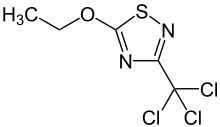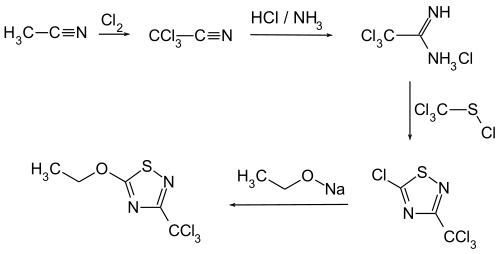Etridiazole
Etridiazole is a fungicide and pesticide used for prevention of pythium ultimum on cotton plants.[2]
 | |
| Names | |
|---|---|
| IUPAC name
5-ethoxy-3-(trichloromethyl)-1,2,4-thiadiazole | |
| Identifiers | |
3D model (JSmol) |
|
| ChEBI | |
| ChemSpider | |
| ECHA InfoCard | 100.018.175 |
| EC Number |
|
| KEGG | |
| MeSH | C014547 |
PubChem CID |
|
| UNII | |
CompTox Dashboard (EPA) |
|
| |
| |
| Properties | |
| C5H5Cl3N2OS | |
| Molar mass | 247.518 g mol−1 |
| Appearance | Pure samples are colourless and odourless, impure samples take on a pale yellow appearance with a mild, persistent odour |
| Density | 1.497 g cm−3 [1] |
| Melting point | 22 °C (72 °F; 295 K) |
| Boiling point | 95 °C (203 °F; 368 K) at 1 mmHg |
| 0.117 g dm−3 | |
| log P | 3.37 |
| Vapor pressure | 0.011 mmHg/1.43 Pa at 25°C |
| Acidity (pKa) | 2.27 |
| Hazards | |
| Flash point | 154.5 °C (310.1 °F; 427.6 K) |
| Lethal dose or concentration (LD, LC): | |
LD50 (median dose) |
1028 mg/kg (rat, oral) 2000 mg/kg (mouse, oral) 779 mg/kg (rabbit, oral) 1700 mg/kg (rabbit, dermal) |
Except where otherwise noted, data are given for materials in their standard state (at 25 °C [77 °F], 100 kPa). | |
| Infobox references | |
Synthesis
Etridiazole can be synthesised from acetonitrile as follows:

It can also be is produced by the reaction of trichloroacetamidine hydrochloride with trichloromethanesulfenyl chloride, and then with sodium hydroxide in ethanol.[3]
Reactivity
Etridiazole is stable under normal conditions,[4] but degrades upon continuous exposure to sunlight,[5] and is hydrolysed by alkalis.[6] When heated to decomposition, it emits toxic fumes of hydrogen chloride, sulfur oxides, and nitrogen oxides.[7]
Safety
Etridiazole has been classified as a Group B2 Probably Human Carcinogen.[8]
gollark: Except it's shared between *all computers* still.
gollark: Fun fact: PotatOS deliberately emulates the old string metatable bug!
gollark: When they run through the discord bridge.
gollark: Links ingame get \:confused\: in them.
gollark: I wonder if I can get a reasonably small bluetooth keyboard for my phone.
References
- MacBean C, ed; e-Pesticide Manual. 15th ed., ver. 5.1, Alton, UK; British Crop Protection Council. Etridazole (2593-15-9) (2008-2010)
- "Applying a Fungicide May Prevent Cotton Replanting". Ag Alert. March 27, 2002.
- Muller F et al; Ullmann's Encyclopedia of Industrial Chemistry 7th ed. (1999-2012). NY, NY: John Wiley & Sons; Fungicides, Agricultural, 2. Individual Fungicides. Online Posting Date: October 15, 2011
- Worthing, C.R., S.B. Walker (eds.). The Pesticide Manual - A World Compendium. 7th ed. Lavenham, Suffolk, Great Britain: The Lavenham Press Limited, 1983., p. 252
- Tomlin, C.D.S. (ed.). The Pesticide Manual - World Compendium. 10th ed. Surrey, UK: The British Crop Protection Council, 1994., p. 420
- Spencer, E. Y. Guide to the Chemicals Used in Crop Protection. 7th ed. Publication 1093. Research Institute, Agriculture Canada, Ottawa, Canada: Information Canada, 1982., p. 279
- Lewis, R.J. Sr. (ed) Sax's Dangerous Properties of Industrial Materials. 11th Edition. Wiley-Interscience, Wiley & Sons, Inc. Hoboken, NJ. 2004., p. 1623
- USEPA Office of Pesticide Programs, Health Effects Division, Science Information Management Branch: "Chemicals Evaluated for Carcinogenic Potential" (April 2006)
This article is issued from Wikipedia. The text is licensed under Creative Commons - Attribution - Sharealike. Additional terms may apply for the media files.